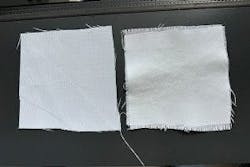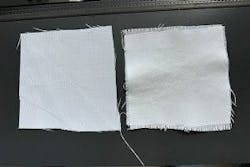UMass Amherst Researchers: Chalk-Based Coating Could Provide Relief from Sweltering Heat
University of Massachusetts Amherst researchers say a chalk-based coating could provide cooling relief to anyone exposed to sweltering summertime temperatures.
The research team presented their results at the American Chemical Society's (ACS) fall conference the week of Aug. 18 in Denver.
The coating cools the air underneath treated fabric by up to 8° F.
The team is building on efforts to develop textiles that deflect the sun’s rays while pushing out natural body heat — a process known as radiative cooling, said Evan Patamia, a graduate student at the University of Massachusetts Amherst, who presented the team’s results at the conference.
Some of those materials have light-refracting synthetic particles, such as titanium dioxide or aluminum oxide, embedded into spun fibers. Others use organic polymers, such as polyvinylidene difluoride, which require per- and polyfluoroalkyl substances, or PFAS.
But scaling these materials for commercialization isn’t sustainable, according to Trisha Andrew, a chemist and materials scientist working with Patamia.
Andrew and colleagues previously created a technique to apply durable polymer coatings on fabric called chemical vapor deposition (CVD). The method requires fewer steps and less environmental impact than other ways to attach coatings.
They then combined this process with calcium carbonate, the main component in limestone and chalk, drawing inspiration from its historical use as a plaster to keep homes cool in extremely sunny environments.
When the researchers tested the material on a hot day, they found air temperatures were 8° F cooler under the treated fabric. The material proved to be up to 15° F cooler than untreated fabrics under the same conditions, according to the research team.
“We see a true cooling effect,” says Patamia. “What is underneath the sample feels colder than standing in the shade.”
The researchers are hoping the research, funded by the U.S. National Science Foundation, could lead to pilot-scale production.

